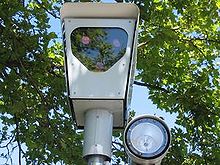Many red light cameras put in low-crash areas, Tribune study finds by Chicago Tribune
Nearly half of the Chicago red light cameras included in a new Tribune study did nothing to make drivers safer and may have caused an increase in injury-related crashes. Researchers hired by the Tribune to analyze the effects of the city’s cameras said the finding involved 43 of the 90 camera intersections in the study — the ones that averaged fewer than four injury crashes a year before red light cameras were installed. The small number of total crashes makes it difficult to know for certain whether the cameras were to blame for the increases, but the scientists from the Texas A&M Transportation Institute said they are confident in their conclusion that the cameras offered no safety benefit at those intersections. “Over four (injury crashes per year) you see a benefit, but less than four you don’t see that benefit,” said researcher Srinivas Geedipally, who co-wrote the study with professor Dominique Lord. “So is it worth putting the cameras at those locations? “That’s a question you may want to ask the mayor.” A Tribune review of state accident data showed there are 73 such intersections that averaged fewer than four injury crashes a year before getting red light cameras, suggesting the cameras may have provided no benefit or even increased injury crashes. Cameras at those intersections have generated more than $140 million in ticket revenue for the city, the Tribune found. The findings raise new questions about whether the cameras deployed by the city are making the streets safer, as city officials have contended, and whether they are being installed in the right locations. As the Tribune reported Sunday, the new study also concluded that red light cameras in general have not reduced injury-related crashes at the Chicago intersections where they were installed. The cameras reduced right-angle “T-bone” crashes by 15 percent but increased rear-end collisions by 22 percent, the study found. City officials have said red light cameras were placed at intersections with high crash rates. But Chicago’s inspector general, who has tried to document how the red light program grew from a tiny trial project in 2002 to a 350-camera network, reported last year that no records exist to prove that contention. Federal prosecutors have offered up another explanation in the form of a recent plea agreement from the bagman in a $2 million cameras-for-cash scandal that has rocked City Hall. The convicted bagman admitted in court papers Dec. 10 that he passed along a fortune in bribes to a key city traffic manager, including a $1,500-per-camera commission. The more cameras installed, the wealthier the men became, prosecutors allege. The $2 million bribery conspiracy is staggering even by Chicago’s corruption standards, as are the financial stakes for the city and for Redflex Traffic Systems Inc., which was fired by Mayor Rahm Emanuel amid the scandal. The company earned more than $124 million from its Chicago contracts; the city has collected more than $500 million in camera-generated revenue for its cash-strapped budgets. Since exposing the first inklings of scandal in the program more than two years ago, the Tribune has sought to explain the implications of a traffic program unlike any other in the nation — its origins, its operations and its effects on Chicago drivers. The Tribune has uncovered a program that runs counter to prevailing transportation wisdom, that has tagged thousands of drivers unfairly and that has fallen dramatically short of providing the safety benefits that two mayors have long stood behind. The Tribune-commissioned study determined that cameras are responsible for just a 15 percent reduction in right-angle crashes that caused injuries, the often dangerous collisions known as “T-bones.” At the same time, the study documented a corresponding 22 percent increase in rear-end crashes that caused injuries. Those findings undercut claims by the Emanuel administration of a 47 percent reduction in T-bone crashes and a smaller reduction in rear-end crashes. Diving deeper into the data, the researchers then looked specifically at the dozens of intersections in the study where crash numbers were low before cameras were installed. They found no decrease in injury-causing crashes of any type at those locations. In fact, they found such accidents increased after the cameras were installed, though the small number of crashes makes it difficult to know whether the cameras were to blame. The research was conducted on 90 Chicago camera intersections and a control group of 59 similar intersections that have never had cameras. A Tribune examination of the entire camera system found 73 of 190 camera intersections during the study period — nearly 40 percent — averaged fewer than four injury crashes a year before the cameras went up. Joseph Schofer, an associate dean at Northwestern University’s McCormick School of Engineering and Applied Science and traffic expert used by the city of Chicago, said the study supports “the notion that good results come where you put the (cameras) in places where there is a large crash experience related to running red lights — where there is a problem. “If you put them where there isn’t a problem, the results are inverted,” he said. “Life is like that: Deliver the medicine where the hurt is; if you put it where the hurt is not, expect to make things worse.” Chicago Transportation Commissioner Rebekah Scheinfeld promised to take the Tribune’s findings under consideration but said the Emanuel administration has already begun to overhaul the problem-laden red light camera program it inherited. She said the office now conducts annual reviews of the program’s effectiveness that have already led to the removal of 32 cameras at 16 intersections throughout the city. That includes a handful of cameras among the 73 with the low annual injury crashes. “This is an interesting subset,” she said during a recent interview at City Hall. “What is happening at those locations where we are not seeing a marked change? Are there other changes in the statistics? “We will be considering the performance of the entire program, of all the locations in the program as part of our annual review and part of the potential decommissioning of cameras.” Neither Scheinfeld nor any of the top management of CDOT was around when the red light camera program blossomed and offered little insight into how intersections were chosen. But Deputy Director David Zavattero said in a recent interview that he helped build a list of top crash intersections in 2006 that was designed to aid the selection of red light camera locations. He said he had no role in actually choosing the intersections or in how the list he developed was used. “That was more a budgetary question of what was available resources to install these cameras,” Zavattero said. “These were expensive cameras to install.” In a 2013 examination of the camera program, the inspector general found that only 42 percent of the cameras installed were on the list of top crash intersections and questioned whether it was used as the basis of site selection. “It’s troubling that CDOT cannot produce documentation or an analysis demonstrating how each camera location was chosen, including all of those currently in operation,” the inspector general wrote. “The majority of these camera location decisions were made five or more years ago, when virtually none of CDOT’s current leadership was involved with the program. However, cameras installed years ago are still in operation today and have been throughout the two-year tenure of CDOT’s current leadership.” Scheinfeld told the Tribune the city is improving its oversight. “The past management of this program was unacceptable, and we have instituted a lot of reforms in less than 12 months to make sure that we have stricter management and stronger performance,” she said. Experts familiar with Chicago’s camera program said the city needs to do more. Joseph Hummer, chairman of the civil and environmental engineering department at Wayne State University, said the Tribune findings suggest a serious lack of professional analysis and oversight in Chicago’s program. “They need to reimagine the entire program and do it well,” he said. “Do it right this time.”
Improvements to the program won’t necessarily make it more popular with drivers, whether it’s those who get $100 tickets or people like Jeanette Chatman, who blames her rear-end accident on a camera. Chatman, 57, was on her way to her job as a pharmacy technician in July 2010, when her car was hit from behind by a pickup truck at the corner of Halsted and 95th streets. “I’ve had back and neck pain ever since,” said Chatman, who was taken by ambulance to the hospital with minor injuries. “I know for a fact it was the camera, because I was stopping to make sure I didn’t get a ticket.” According to the Chicago police report, Chatman “stopped abruptly” and was hit from the rear by Michael Shannon, 42, of Merrillville, Ind. The report indicates he was ticketed for the accident. “Of course it was the red light camera, but I am from Indiana, so I had no idea when it was happening,” Shannon said. “The light was turning yellow, and all the sudden she speeds up, so I decide to go with her, and then she slams on her brakes. “I had no idea why she would do that, until later all the people at the bus stop who saw were telling me about the cameras,” he said. “They were all laughing about it. And I look up and sure enough there’s these big black boxes up there.” Shannon noted that Chicago stoplights have built-in delays when traffic signals are red in all directions to lessen the chances of drivers making bad choices that lead to accidents. “And then they put those cameras up, and it changes everything,” he said. [email protected] [email protected]







